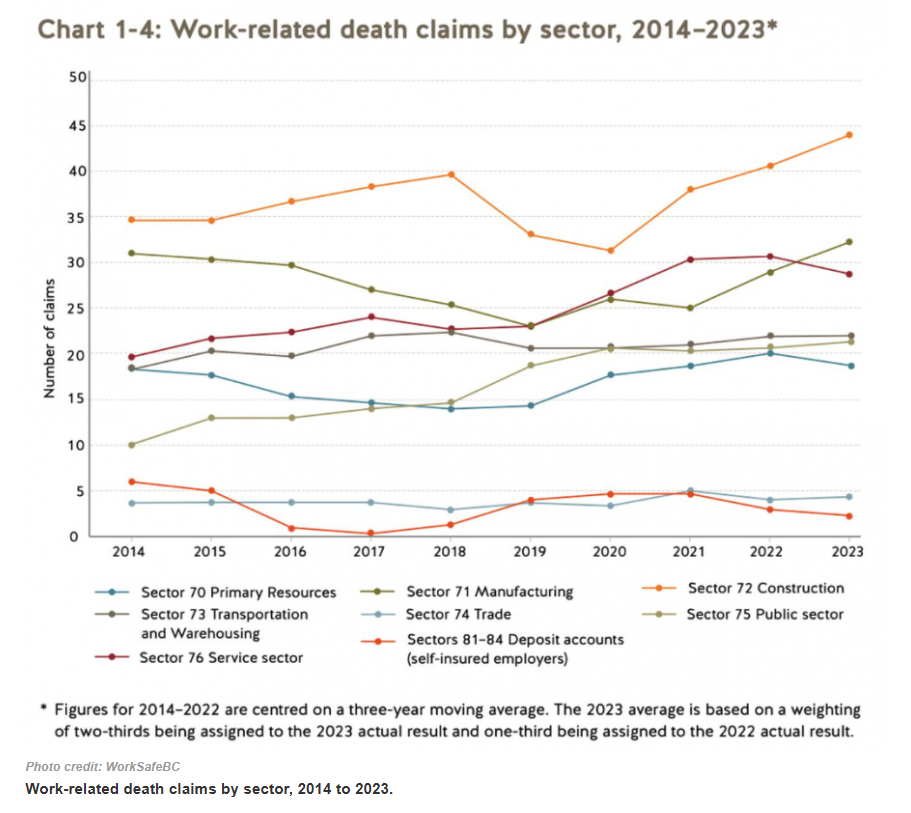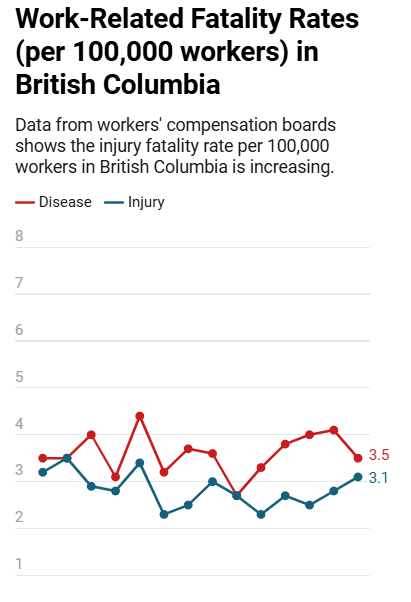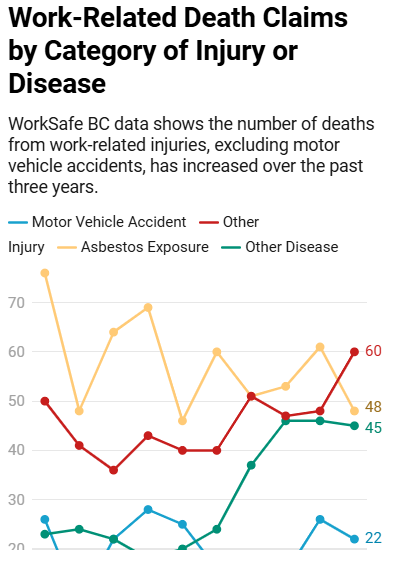
'We're talking about the loss that survivors experience — children, spouses, friends, co-workers — from people dying due to injury or occupational disease'

A new report from the University of Regina has revealed troubling signs in British Columbia’s workplace fatality trends — prompting calls for regulators and compensation boards to act swiftly to improve injury reporting and prevention measures.
The long-standing downward trend in B.C.'s workplace fatality rate has plateaued, and in some categories, has begun to reverse. The 2025 report, which reflects fatalities occurring in 2023, highlights these developments.
Notably, there has been a steady increase in the province's traumatic injury fatality rate over the past three years — a category that includes fatalities from falls, electrocutions, and contact with machinery. While not dramatic in scale, University of Regina human resources professor Sean Tucker called the trend “concerning” in an interview with The Tyee.
Eight in 10 directors and officers across the world cited workplace health and safety as a major risk for their organisations this year, according to a previous report from WTW and Clyde & Co.

WorkSafeBC data show that construction and manufacturing are leading the recent increase in traumatic fatalities. Deaths in the construction industry have steadily risen since 2020, with manufacturing also displaying an upward trend.
These two sectors appear to be “primarily driving the overall increase in work-related traumatic fatalities in B.C.,” said Tucker.
Meanwhile, the health-care sector remains a persistent national concern. Tucker pointed to the combination of high injury rates and chronic staffing shortages as a key issue requiring immediate attention from regulators.
“We have a significant staffing shortage in health care, and yet we manage to injure a lot of health-care workers each year. So we need to work on those working conditions,” said Tucker in The Tyee interview, posted in Victoria Now.

Conversely, after five consecutive years of increase, B.C.’s occupational disease fatalities declined in 2023. Still, Tucker cautioned that these figures may underrepresent the real toll due to reporting delays and the long latency period associated with many occupational illnesses.
He highlighted several systemic shortcomings in data collection that hinder accurate assessment. The report is based on accepted workers’ compensation claims — but many incidents go unreported, or are suppressed by employers.
“Injury reporting is an issue. We know that that’s a function of both workers not being aware of the requirement to report, or viewing their injury as not serious enough to report,” Tucker told The Tyee.
“We also know that there’s claim suppression among some employers, so what we see at the end of the day is only a representation of some of what’s been accepted as an injury claim.”
Underreporting is also widespread in occupational disease cases, where workplace-related illnesses such as cancers may be missed if no occupational history is taken or if a connection to work is never made, according to Tucker.
Disparities in how fatalities are recorded across provinces further complicate national comparisons. For instance, not all jurisdictions classify heart attacks at work as occupational fatalities. Variations also exist in how claims involving workplace violence or harassment are processed — a concern Tucker believes “can affect all of the rates we calculate.”
In 2024, workplace injuries and illnesses claimed the lives of 146 B.C. workers, according to WorkSafeBC.
Of these workers:

Beyond physical injuries, Tucker underscored the importance of recognising bullying and harassment as serious occupational health issues.
“This is a human rights issue. It’s a matter of dignity, but it’s also a health and safety issue,” he said. “Having stats on bullying and harassment in the workplace is really important.”
Previously, Loblaws expanded the use of body cameras in retail stores.
Tucker’s reports — written with University of British Columbia public health researcher Anya Keefe — makes several recommendations, according to Victoria Now:
“We hope that regulators, those with the responsibility for enforcement, will read the report,” Tucker said. “We want to prevent serious injury and death in the workplace and that’s why we do this work.”
B.C. marked the National Day of Mourning on Monday.
"Today, we pause to honour the workers who never came home,” said Jennifer Whiteside, B.C.’s minister of labour. “Every workplace fatality is a tragedy that ripples through families, coworkers and entire communities. We stand with those who carry the grief of that loss, and we reaffirm our commitment to stronger protections and a culture that truly values the health and safety of every worker."